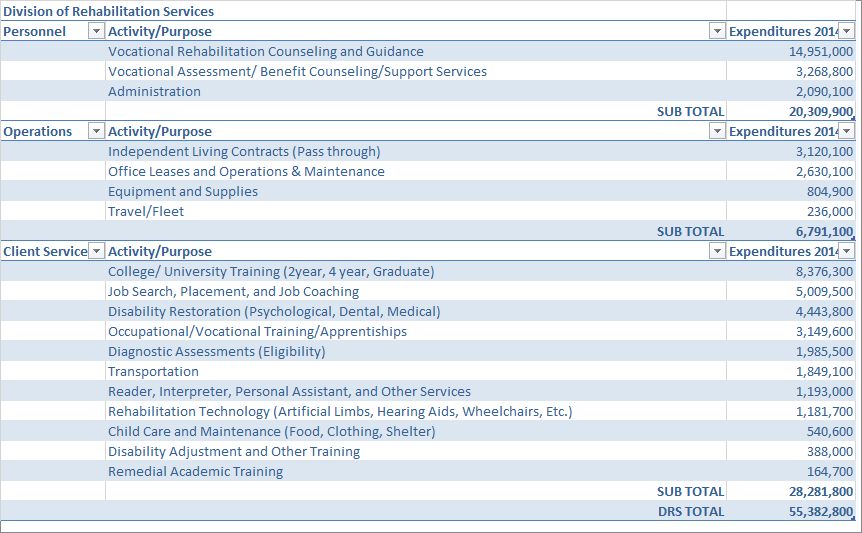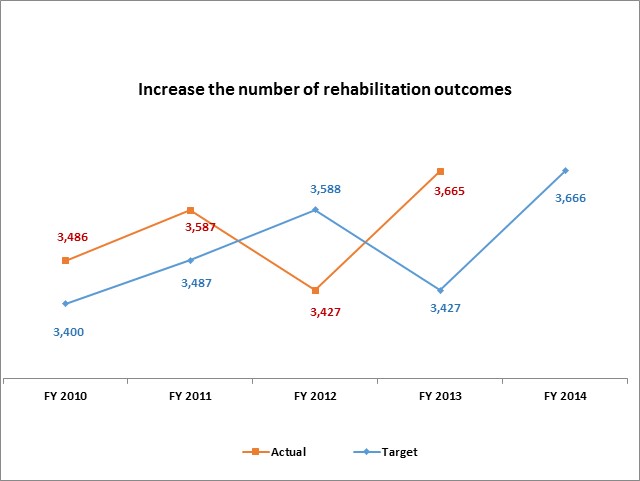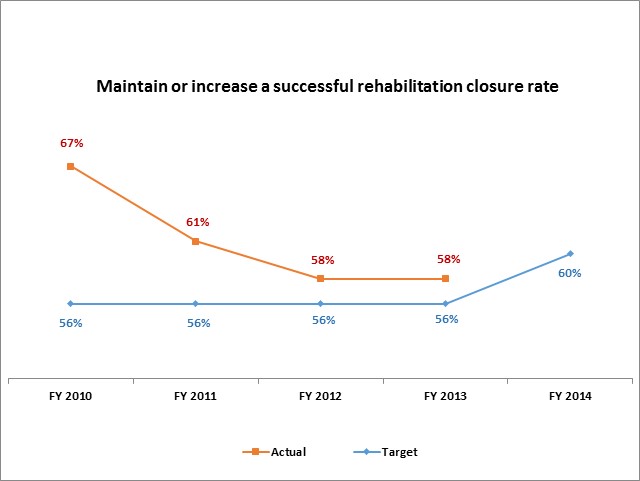Rehabilitation Services is comprised of two major programs: Vocational Rehabilitation and Independent Living.
During the 2015 General Session, the Legislature appropriated for Fiscal Year 2016, $47,628,400 from all sources for Rehabilitation Services. This is an 18.8 percent reduction from Fiscal Year 2015 revised estimated amounts from all sources. The total includes $15,012,800 from the General/Education Funds, a reduction of 28.6 percent from revised Fiscal Year 2015 estimates.
In addition to statewide compensation and internal service fund cost increases, the following appropriation adjustments were made during the 2015 General Session:
For the most recent completed fiscal year, the following information represents the purposes for which the money was used:



Regarding the negative trend greater than 5% to maintain or increase a successful rehabilitation closure rate from the Vocational Rehabilitation program performance measures, the agency states, "This negative measure is a first for the division. In anticipation of an Order of Selection (Wait List), DRS strategically directed VR Counselors to review their client bases and close the cases of any clients not making adequate progress toward employment in an attempt to ensure that limited resources were available to individuals making progress toward employment. This resulted in DRS having more unsuccessful closures than were planned for in the development of these performance measures."
Vocational Rehabilitation provides services directed towards the goal of employment. Services include clinical vocational rehabilitation counseling and guidance, comprehensive assessment of rehabilitation needs, assistive technology, job training, job placement, and post-employment follow-up. Eligibility for vocational rehabilitation is based on the presence of physical or mental impairment that constitutes a substantial impediment to employment. Once determined eligible, an individual will work with a counselor to develop an individualized program that leads to employment.
The division provides statewide services to people with disabilities through 28 offices. All 41 school districts in the state, through cooperative agreements, receive vocational rehabilitation services. Vocational rehabilitation counselors are assigned to each high school in the state. The division also works through cooperative agreements with the Department of Workforce Services, the Division for Children with Special Health Care Needs, the State Board of Regents, the Division of Services for People with Disabilities, the Division of Medical and Healthcare Financing in the state Department of Health (Medicaid), and the Division of Substance Abuse and Mental Health.
Utah's Independent Living Centers enable people with disabilities statewide to live independently. The Division of Rehabilitation Services works with the independent living centers, the Division of Services for the Blind and Visually Impaired, and the Utah Statewide Independent Living Council to coordinate services. Services provided include: peer support, skills training, recreation and community integration programs, and assistive technology.
Eligibility for the program is based on the presence of a disability coupled with the ability to benefit from services. All services are based on individual need in accordance with an Independent Living plan that includes specific goals and objectives. Services are time-limited and designed to assist consumers to increase and maintain their levels of independence and community participation.
Currently, six Independent Living Centers (ILC's) and four satellites operate throughout Utah, including: Options for Independence in Logan with a satellite in Brigham City; Roads to Independence Center in Ogden; Utah Independent Living Center in Salt Lake City, which also operates a satellite in Tooele; Central Utah Independent Living Center in Provo; Active Re-Entry Independent Living Center in Price, which also operates two satellites in Vernal and Moab; and Red Rock Independent Living Center in St. George. Each ILC operates on a combination of State and federal funding. All ILCs provide, at a minimum, the services detailed above.
The federal government provided the largest portion of division funding at over 78 percent in FY 2014. A combination of state funds (Education Fund and General Fund) contributes roughly 21 percent of division funds. The remaining division revenue is generated through dedicated credits. The division's dedicated credits revenue comes from a Department of Workforce Services receivable contract, a Department of Health receivable contract, and the Department of Education -- At Risk Students receivable contract, all of which contribute to this revenue source.
The division's dedicated credits revenue comes from a Department of Workforce Services receivable contract, a Department of Health receivable contract, and the Department of Education -- At Risk Students receivable contract, all of which contribute to this revenue source.
Rehabilitation Services receives revenue from state General Fund of $270,400. This funding stream has existed at or near the current level for several years. The General Fund appropriation provides for the Utah Center for Assistive Technology (UCAT). UCAT began as a federal grant serving multiple state agencies, such as the Division of Services for People with Disabilities, the Division for Children with Special Health Care Needs, the Division of Aging, and the Department of Workforce Services. When the federal grant ended, the Legislature continued the program and placed the Center under the direction of the Utah State Office of Rehabilitation. The General Fund is used to continue services to other non-education related state agencies. Note: the Utah Center for Assistive Technology (UCAT) is a separate entity and different than the Utah College of Applied Technology, also known as UCAT.
COBI contains unaudited data as presented to the Legislature by state agencies at the time of publication. For audited financial data see the State of Utah's Comprehensive Annual Financial Reports.